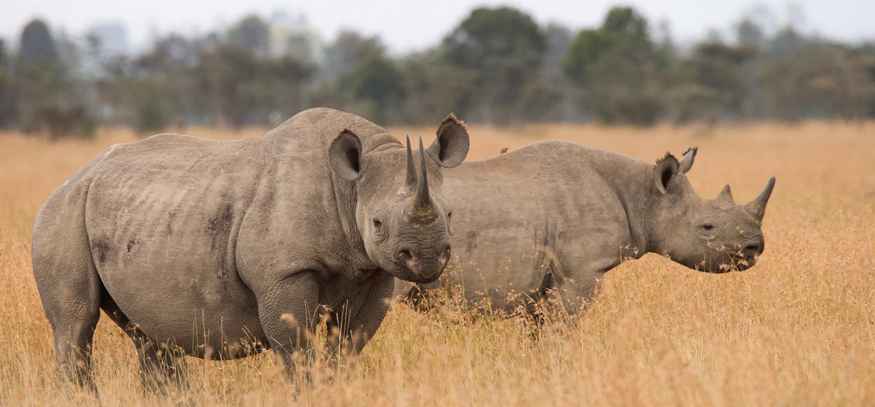Ol Pejeta Conservancy: Where wildlife conservation meets responsible tourism

Ol Pejeta Conservancy, located in Central Kenya's Laikipia County, is a pioneering wildlife sanctuary and the largest black rhino sanctuary in East Africa. Spanning approximately 90,000 acres, it is renowned for its innovative conservation efforts, which integrate wildlife protection with community development and sustainable agriculture. Ol Pejeta means “Place of burning”. Hundreds of years ago, the pastoralist communities named it that because they use the area to kill ticks by burning the grass.
Historical Background
Originally a cattle ranch established in the 1940s, Ol Pejeta transitioned into a conservation area in response to the severe decline of wildlife populations due to poaching. In 2003, the land was purchased by Fauna & Flora International with funding from the Arcus Foundation, marking a significant shift towards conservation. This transformation aimed to protect endangered species and restore the ecosystem while also benefiting local communities through economic development initiatives.
Conservation Efforts
Ol Pejeta is home to two of the world's last three northern white rhinos, alongside a thriving population of black rhinos, which represents about 17% of Kenya's total black rhino population. The conservancy employs advanced anti-poaching measures, including armed security and the establishment of predator-proof zones to safeguard these magnificent creatures. Additionally, the site features a 300-acre chimpanzee sanctuary, the only one in Kenya, dedicated to rehabilitating animals rescued from the illegal wildlife trade. The conservancy actively engages with surrounding communities, ensuring that conservation efforts translate into tangible benefits for local residents. The conservancy promotes sustainable tourism and agriculture, allowing local communities to thrive while fostering a culture of wildlife stewardship.
Tourism and Visitor Experience
As a popular safari destination, Ol Pejeta offers a range of activities for visitors, including game drives, guided bushwalks, lion tracking, horse riding and visits to the Sweetwaters chimpanzee sanctuary. The conservancy features several accommodation options, from luxury tented camps to private campsites, catering to various preferences and budgets. Entry fees contribute directly to conservation efforts, ensuring that tourism supports the mission of protecting endangered species.
What is the best time to visit Ol Pejeta Conservancy?
The best time to visit Ol Pejeta for wildlife sightings is during the dry seasons, from June to September and December to February. These periods offer optimal conditions for viewing wildlife, as animals congregate around water sources. The wet months of April and November are less ideal due to heavy rains, which can hinder visibility and accessibility. Game drives at Ol Pejeta are more favourable in the early morning and late afternoon. During these cooler parts of the day, animals are more active, enhancing the chances of wildlife sightings. Morning drives typically start at sunrise, while afternoon drives conclude at sunset. Additionally, night game drives are available, allowing guests to spot nocturnal species between 7:00 PM and 11:00 PM.
How to Get to Ol Pejeta Conservancy
Getting to Ol Pejeta can be accomplished through various means, whether you prefer flying or driving. Here’s a comprehensive guide on how to reach this remarkable destination:
By Air
Flying is one of the quickest and most convenient ways to reach Ol Pejeta. Here’s how you can do it:
- Departure from Nairobi: Start your journey at Wilson Airport in Nairobi, which is the primary hub for domestic flights.
- Flight to Nanyuki: Several airlines, including Safarilink and Air Kenya, operate daily flights to Nanyuki Airstrip. The flight duration is approximately 45 minutes.
- Transfer to Ol Pejeta: Upon arrival at Nanyuki Airstrip, you can arrange for a transfer to Ol Pejeta, which is about a 45-minute drive away.
By Road
If you prefer a road trip, driving to Ol Pejeta can be an enjoyable experience. Here’s what you need to know:
- Starting Point: Begin your journey in Nairobi. The distance to Ol Pejeta is approximately 200 kilometers (about 124 miles).
- Route: The journey typically takes 3-4 hours, depending on traffic and road conditions. The route is mostly on a tarmacked road, making it accessible for most vehicles.
- Final Stretch: The last 13 kilometers to Ol Pejeta is on a graded dirt road, so be prepared for a slightly bumpy ride.
Whether you choose to fly or drive, reaching Ol Pejeta Conservancy is relatively straightforward. The journey offers stunning views of Kenya's landscapes and an exciting start to your wildlife adventure. Once you arrive, you’ll be ready to explore the incredible wildlife and conservation efforts that make Ol Pejeta a must-visit destination in Kenya.
Entry Fees for Ol Pejeta Conservancy 2024
Ol Pejeta Conservancy has specific entry fees based on visitor category.
Category Adult Child
Citizen (KSH) 2000 1000
Resident (KSH) 3000 1500
Non-Resident (USD) 110 55
Note: Ol Pejeta is cashless, and advance bookings are recommended.
Conclusion
Ol Pejeta Conservancy stands as a testament to the power of integrated conservation efforts that prioritize both wildlife protection and community development. Its innovative approach serves as a model for other conservation initiatives worldwide, demonstrating that sustainable practices can lead to the preservation of endangered species while simultaneously uplifting local communities. As the conservancy continues to evolve, it remains committed to its mission of safeguarding Kenya's natural heritage for future generations.
